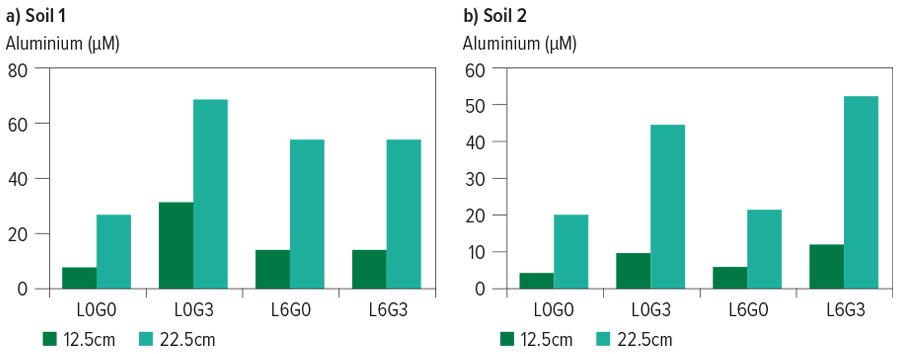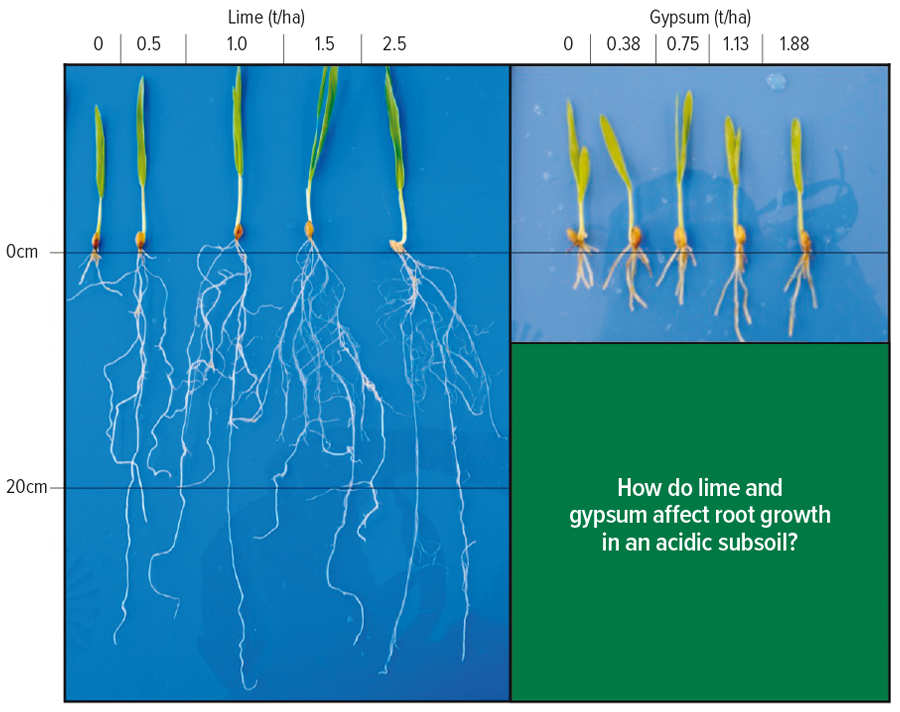Aluminium toxicity brought on by acidic soil conditions impairs crop root growth and yield. On most Western Australian soils, a rough rule of thumb is that two to five milligrams of aluminium per kilogram of soil (measured in the laboratory with 0.01 Mol calcium chloride) is toxic to sensitive species and more than 5mg/kg is toxic to tolerant species.
These numbers have been used as a guide for many years even though, at its core, aluminium concentration measured with 0.01M calcium chloride is a poor predictor of root growth and is poorly correlated to other aluminium laboratory test methods that predict root growth such as 0.005M potassium chloride (Car et al. 1991).
pH is the most important factor affecting aluminium solubility and toxicity and, for this reason, it is:
- the easiest and most-used measurement for making lime decisions; and
- often used as a proxy to estimate aluminium levels.
Some growers have asked whether measuring aluminium can assist lime decisions. If so, it is important the industry has confidence in the laboratory test method used to measure it. New research, as part of GRDC investment DAW00252, is shedding more light on using different laboratory methods to measure aluminium in different soil types, as well as the impact of aluminium on root growth.
When soil pH is above 6.0, aluminium is in a solid state and not in the soil solution – and therefore not toxic to roots. When soil pH drops below about 5.0, aluminium becomes more soluble and dangerous to roots. Aluminium in the soil solution rises exponentially when pH is less than 4.5. Applying lime to acidic soils and lifting pH precipitates soluble aluminium from the soil solution into a biologically inactive (solid) form (Gazey et al. 2014).
Most soils in WA have sufficient amounts of aluminium to cause problems for plant growth if soil pH drops below 4.8. Because aluminium solubility is affected by more than pH, a pH of 4.8 does not automatically mean high soluble soil aluminium. For example, a soil with a pH of 4.5 can have less than 2mg/kg aluminium, which is lower than expected if using pH as a proxy for aluminium levelsand why there are concerns with the test method. If the method does not extract the portion of aluminium that causes damage to growing root cells, then there is little value in knowing the number.

Figure 1: Aluminium levels tended to increase with higher gypsum rates.
The tipping point at which aluminium becomes soluble and toxic is influenced by many soil parameters, especially ionic strength (concentration of ions in solution) as well as clay content, clay minerals, cations and organic matter content and, of course, will depend on the crop species.
To better understand what is going on in the root zone, researchers are testing the pH-aluminium relationship with five different pH test methods and six aluminium test methods, on 18 soil types with varying pH buffering capacities and clay content (three to 20 per cent).
The pH test methods were:
- water;
- 0.01 Mol calcium chloride;
- 0.005 Mol potassium chloride;
- 1.0 Mol potassium chloride; and
- soil solution.
The aluminium test methods were:
- 0.01 Mol calcium chloride;
- 0.005 Mol potassium chloride;
- 1.0 Mol potassium chloride;
- soil solution;
- exchangeable aluminium percentage; and
- reactive aluminium.
So far, the pH-aluminium relationship remains strong across the different test methods, suggesting pH is an adequate indicator of available aluminium. Data interrogation is still underway, where multi-regression analysis should tease out how the various soil parameters – individually and together – affect aluminium availability and root growth.
Glasshouse trials growing La Trobe barley and Mace wheat will check impacts on root growth and begin developing critical levels for different crop species. The next step will be to run field trials on a range of soil types and aluminium levels.
For now, pH is still the best test to support liming decisions to reduce the impact of aluminium toxicity on crop production.
More information: Gaus Azam, gaus.azam@dpird.wa.gov.au
This article was produced as part of the GRDC ‘Maintain the longevity of soils constraints investments and increase grower adoption through extension – western region’ investment (PLT1909-001SAX). This project is extending practical findings to grain growers from the five-year Soil Constraints – West suite of projects, conducted by the Department of Primary Industries and Regional Development, with GRDC investment.
Lime and gypsum impact on root growth
There are a lot of assumptions and anecdotes about the effects of gypsum and lime on root growth in acidic subsoil. These assumptions are best tested with controlled experiments.
 Figure 1: Root growth in an acidic subsoil treated with lime (left) and gypsum (right). Source: Gaus Azam
Figure 1: Root growth in an acidic subsoil treated with lime (left) and gypsum (right). Source: Gaus Azam
One glasshouse trial by Western Australian Department of Primary Industries and Regional Development researcher Gaus Azam studied the impact of gypsum and lime on root growth in acidic subsoil (pH about 4.0).
Researchers used five gypsum rates (equivalent to zero, 0.38, 0.75, 1.13 and 1.88 tonnes per hectare) and five lime rates (zero, 0.5, 1.0, 1.5 and 3.5t/ha). As gypsum is more soluble than lime (moves more easily into the soil), it was applied at the surface, while the lime was mixed in.
Roots did not respond to gypsum. Optimal root growth was achieved with 1.5t/ha of lime. These results support the previous work that gypsum is not a substitute for lime to raise soil pH in an acidic soil.
This research follows on from field work at Kalannie and other glasshouse research (as part of GRDC project DAW00252) trying to tease out the impacts of gypsum on the root zone in acidic soils.
More information: Gaus Azam, gaus.azam@dpird.wa.gov.au

























































